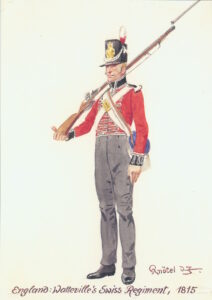The de Watteville Regiment
The 99 Lithuanians who served during the War of 1812 were members of the Swiss de Watteville Regiment. It was a unit raised during the early nineteenth century to guard Swiss independence. When a poor economy improved, military service was no longer the first career choice for many Swiss men.
As a result of the shortages, the regiment had to accept recruits from neighbouring countries. Among the first new soldiers were many who left Napoleon’s army after the French collapse in Sicily. Other men came from Malta, Gibraltar, and Cadiz, places where the de Watteville regiment was based from 1802 through 1810.
Many recruits came from the British Army Foreign Depot. By 1813, some 56,000 prisoners-of-war were being held in camps and on prison ships. Holding these prisoners was a significant cost to the British government. And it already had recruitment challenges of its own.

Some of the foreign soldiers were likely to have been housed on these ships as prisoners of war. Painting. Daniel Turner, Ambrose-Louis Garneray, circa 1812-14. National Maritime Museum, Greenwich, London, Caird Collection.
Ever practical, the British government decided to solve two problems at once. Why not encourage prisoners to join the British Army? Among those who switched sides were Grand Duchy Lithuanians. Once they had signed up, the Foreign Depot directed them to the de Watteville Regiment. One of these men was Andreas Korgto, a young man we will meet several times. His imagined journal forms part of this presentation.

Prisoners baking their own bread, Norman Cross Prisoner of War camp, Peninsular war. Watercolour from a sketchbook. Artist: Captain Durrant. 1802-1813. Hampshire Cultural Trust, FA 1990.23.87.
The cultural and linguistic diversity of the de Wattevilles was remarkable. By 1810, the regiment included men drawn from Dutch, Flemish, French, Greek, Hungarian, Italian, Polish, Russian, and Swiss backgrounds. Colonel Louis de Watteville, the regiment’s commander, recognised that the mix of languages spoken would make for confusion and disaster on the battlefield.
To address the language challenge, Col. de Watteville formed a school to teach his men the basics of English, of course, used by the wider British army. Classes were also open to the children who accompanied the regiment. The school opened for classes on January 25, 1811.
With this education its soldiers and their previous experience in Napoleon’s armies, the regiment earned a reputation for competency. Because of their reputation, when the Napoleonic wars came to an end, the de Watteville regiment was sent to North America to fight another war.


